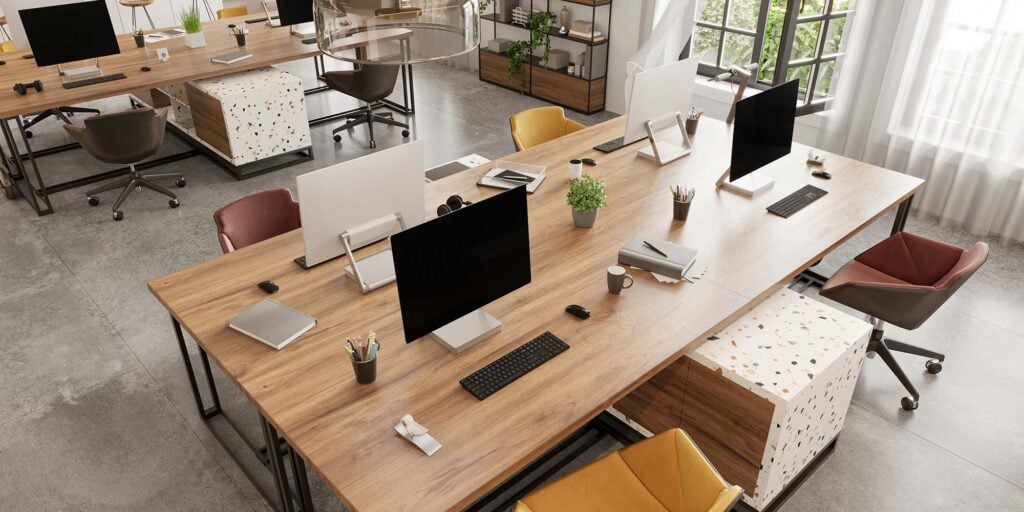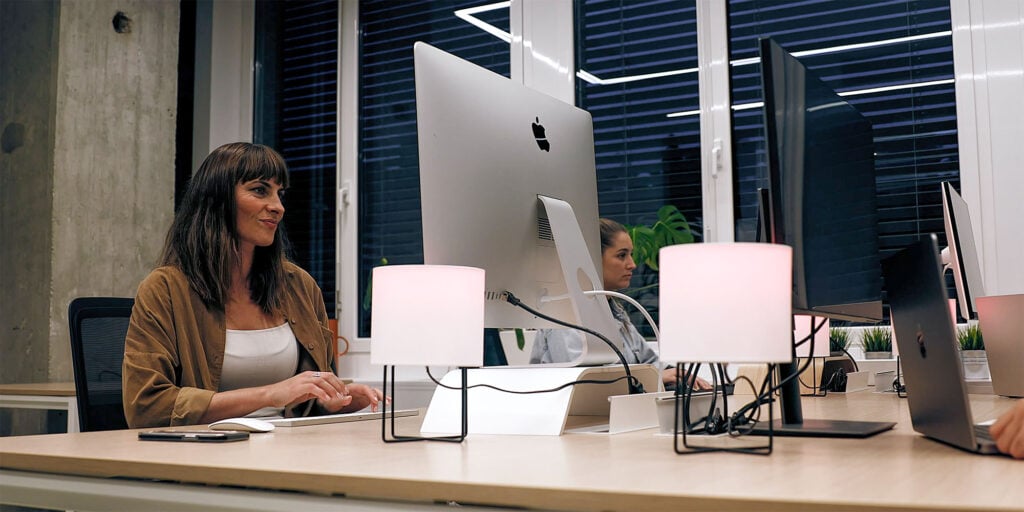Why desk sharing at work is taking over in 2026?
In 2025, shared desks are becoming the norm as 62% of employers aim for flexible desk sharing at work. The percentage of dedicated desks has dropped from 51% in 2021 to just 40% in 2024, reflecting a clear shift toward shared desk models to optimize office space and support hybrid work.
Desk sharing at work means employees don’t have permanent desks but instead reserve a shared desk daily or for flexible periods. One common worry? Showing up to the office and not having a desk available. It’s a valid concern, and there’s a simple way to avoid that frustration. We’ll get to that in a moment. First, let’s take a closer look at what desk sharing actually is, before diving into its pros, cons, and how a little planning can make all the difference.
Quickly jump to:
- What is desk sharing at work?
- The benefits of shared desks in an office
- The drawbacks of desk sharing at work
- How to get your office to embrace desk sharing?
- FAQ about desk sharing at work
What is desk sharing at work?
Shared desk systems in modern offices have become increasingly popular. But what is desk sharing, exactly? Desk sharing at work, also known as a shared desk model, means that employees do not have a permanent, designated desk. Instead, they reserve a specific desk for each day they plan to work in the office, typically on a day-by-day basis.
Some companies allow employees to book desks for longer periods, such as a few hours or even an entire week, but most use a daily reservation system. This flexible approach supports hybrid work and helps maximize office space.
To manage this setup, many companies implement a formal desk booking solution like the Joan Desk booking system, which makes it easy for employees to see which shared desks are available and reserve them ahead of time. Others may take a more informal approach, simply letting employees find any open desk when they arrive.
However, without a proper system, desk sharing at work can lead to frustration: employees may waste time searching for an available desk, or worse, show up to find none free.
P.S. If you want to read about shared desk etiquette and how to make the experience smoother for everyone, check out our quick guide.

The benefits of desk sharing at work
Optimal use of space
Desk sharing at work allows companies to cut down on desk space and use desks more economically. They can keep the number of desks down to a minimum to cater to what their workforce needs. This cuts down on real estate costs and office furniture expenses.
Taking this approach is especially beneficial for companies working with a hybrid work-from-home model that either allows the employees to choose when they come into the office or that have schedules to rotate employees coming in.
Flexibility
This setup provides flexibility for employees. They can find a desk that suits their working needs for the day.
For example, if there is a group project that needs to be done, members of that group can find desks next to each other for the duration of the project.
Minimal clutter
When an employee has a permanent designated desk, there can often be a buildup of clutter over time. Whether it’s mugs, old documents, stationery, or food products, a cluttered workspace can be distracting.
With desk sharing at work, employees have to pack up their belongings every day.
Increases sociability
In larger offices, having a permanent desk often means that employees will form closer bonds with those situated at desks around them.
Desk sharing at work allows workers to interact with different people each day. This helps build social skills and forms a closer workforce overall.

The drawbacks of desk sharing at work
No personal touches
Having a permanent desk means employees can add their personal effects to the space, such as photographs, posters, calendars, etc.
Desk sharing at work eliminates this, as employees have to pack up every item by the end of the day. This may make the space feel more unfamiliar.
Time wasting
Arriving at the office and going to a permanent desk is usually effortless. Your employees will already have all their necessities permanently set up there.
With desk sharing at work, there is a process of finding an available desk, unpacking belongings, and then acclimatizing to the new environment. This can take up some time that could have been used for more productive means
Lack of cleanliness
Sharing desks can be challenging when it comes to hygiene, as the desk will need to be properly sanitized before someone new takes over it.
Cleaning products, such as sanitizers and wipes, should be provided and employees should be instructed to clean the desk when they’re finished using it.
Poor adaptability
In some instances, desk sharing at work can lack adaptability. For example, an employee may receive a last-minute assignment that requires brainstorming or group work.
However, if they have reserved a desk that has occupied surrounding desks, they may not be able to congregate with team members in the workspace as they may clash with other employees who need a quiet area.
How to get your office to embrace desk sharing?
Getting your team on board with desk sharing at work doesn’t have to be hard. Here’s how to make it easier:
- Let people know why you’re doing this, whether it’s to save space, support hybrid work, or make better use of the office.
- Get employees involved early. Ask what would make desk sharing work well for them.
- A good desk booking app makes it simple to reserve a desk and avoids confusion.
- Make sure everyone knows the basics, like cleaning up after themselves and only using desks they’ve booked.
- Try it with one team first. Learn what works, then roll it out to the rest of the office.
- Share the wins, like better flexibility or more space. When people see it works, they’ll be more open to it.
Conclusion
Desk sharing at work may have some challenges, but for the most part, it is a modern technique that encourages minimalistic practice in the office and saves money and resources in the long run.
It also allows flexibility for the employees to move around to suit their working needs and encourages more socializing in the workplace to form a closer workforce.
If you’re interested in implementing desk sharing in your workplace, be sure to check out Joan today.
Frequently asked questions about desk sharing at work
What is a shared desk?
A shared desk is a flexible workspace that isn’t assigned to one specific employee. Instead of having a permanent desk, employees reserve a desk when they need it, usually for the day. This setup supports hybrid work, saves space, and keeps offices more efficient.
Desk sharing at work allows teams to make better use of office resources, especially when not everyone is in the office every day. With the right system in place, shared desks can offer flexibility without sacrificing productivity.
How do I set up a shared desk?
Here are some steps you can take to set up a shared desk in your office:
- Determine the number of shared desks needed: Based on the size of your office and the number of employees, determine how many shared desks you will need. Make sure to consider factors such as the number of employees who work remotely or travel frequently, and the number of employees who need to be in the office at the same time.
- Choose the location of the shared desks: Select the location of the shared desks based on factors such as natural light, proximity to common areas, and accessibility. It’s important to consider the ergonomics and comfort of the space for the employees.
- Purchase and set up the necessary furniture and equipment: Purchase or rent the necessary furniture and equipment for the shared desks, such as desks, chairs, and filing cabinets. Make sure that the furniture is comfortable, ergonomic, and easily adjustable.
- Choose a desk a reservation system like Joan Desk: Create a system for employees to reserve a shared desk in advance, this can be done through software or apps. This can help to ensure that there are always enough desks available for employees who need them.
- Establish rules and guidelines: Create guidelines for the use of shared desks, such as how to reserve a desk, how to clean and organize a desk, and how to share common spaces.
- Communicate the shared desk system to all employees: Communicate the shared desk system to all employees, including how it works, how to reserve a desk, and the rules and guidelines. Make sure that all employees understand the benefits and how to use the system.
How do I manage the desk that I am sharing?
Managing a shared desk well helps keep the system running smoothly for everyone. Here are a few tips to help you use shared desks at work:
Use your company’s desk sharing at work system to reserve a desk before coming in. This avoids last-minute stress and ensures you have a spot. If you company doesn’t have a desk sharing system in place, check out the one we use.
Only use the desk you’ve reserved, and release it if your plans change so someone else can use it.
Leave the desk as you found it and clear of personal items, wiped down, and ready for the next person.
Store personal belongings in a locker or designated area instead of leaving them at the desk.
Keep noise down, take calls in designated areas if possible, and respect shared space etiquette.
By following these simple steps, you help make desk sharing at work more efficient and pleasant for everyone.
What is the difference between desk sharing and hot desking at work?
The terms “desk sharing” and “hot desking” are often used interchangeably, but they have different meanings.
Desk sharing means multiple employees share the same desk at different times. This setup is usually organized, with specific desks assigned to certain groups of employees who use them based on a schedule. It works well in places where employees have set schedules, like part-time workers or those who only come to the office occasionally.
Hot desking, however, is more flexible. Employees do not have assigned desks; they pick any available desk when they arrive each day. This system suits dynamic offices with employees coming in and out at different times. Hot desking encourages spontaneous interactions and collaboration across different teams.
The main differences are in structure and flexibility. Desk sharing is more predictable, with assigned desks and scheduled use. Hot desking offers more freedom, with no assigned seating and varied daily interactions. Desk sharing is ideal for workplaces with predictable attendance, while hot desking fits better in dynamic environments.
Read more about hot desking on this link.
What should be included in a desk sharing policy?
A solid desk sharing at work policy should cover how to book a shared desk, usage rules, cleanliness expectations, storage options, and what to do if issues arise. It helps set clear guidelines so everyone knows what’s expected.
Read our article on what to include in an effective desk sharing policy.
How can technology support desk sharing?
Technology plays a key role in making desk sharing at work smooth and stress-free. The right tools help employees easily find and reserve a shared desk, track availability, and reduce booking conflicts.
One great example is the Joan desk sharing software. It allows employees to book desks in advance, see what’s available in real time, and even check in when they arrive. It simplifies the entire process without spreadsheets or guesswork.
With smart tools like Joan, desk sharing becomes efficient, organized, and much easier to manage for both employees and office managers.